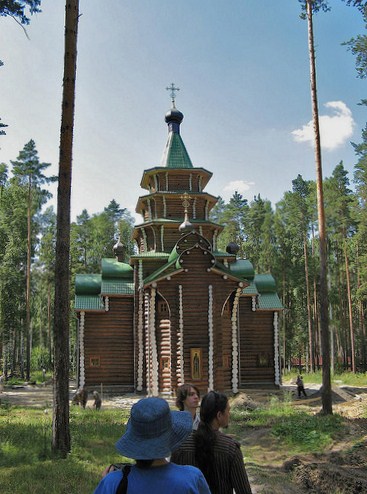
Ivan leads us into the crime site
Our mission today is to visit Ganina Yama, a huge monastery still being built on the site where the remains of the last Tsar and his family were found. It’s a shallow pit where the Soviet revolutionaries had attempted to dissolve, burn and otherwise erase any evidence of the bodies after the execution. We ring up the local tourist bureau to find out how we can get on a tour there, since we’re feeling a little low in confidence with catching the correct sequence of buses to the site and then on having any idea what is going on there in general. We decide to be normal tourists for once. This ends up costing each of us about a thousand roubles (AUD$50) for a private tour with our own guide that includes transport in a car to and from the monastery. We accept and find our way to their office, where we’re soon greeted by a young Russian university student. His name is Ivan and he’s earning some spare money as a guide. His English is good and it’s clear our driver is a friend of his who is along for the financial benefits of the ride. On the way to the monastery we talk about the assassination of the Tsar’s family, something that I’ve read about previously; but all of us wanted to hear his version. With a delightfully wry smile on his face the entire time he tells us the versions according to the Russian government, the orthodox church and some other theories thrown in for good measure.
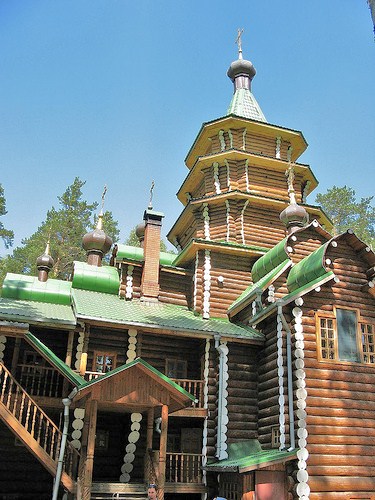
Traditional Russian orthodox wooden church action
Ivan’s descriptions complete my conviction that the entire thing had been run by our good friends Boris and Yuri. In this case there were many people involved over the course of time, but they all had that same charming carelessness of this amazing pair of average Russians.
“Another shot Boris?”
“Tochna Yuri, tochna”
“Boris! We have the Tsar’s family here now in our friend Dom Ipatiev’s house, but the White Army keep trying to release them.”
“Da..da…da…Yuri, we must find a way to fix this problem. I know, we just shoot all of them and leave the bodies to rot.”
“Nyet…nyet…Boris, someone will find them and make them saints to rally the Russian people.”
“Da..da…da…So we shoot them all, then we take bodies somewhere and burn them.”
“But Boris, burning will take so long and the bones might not burn, there are so many of them.”
“Da…da…da…Yuri, we take bodies, cover with acid, then we burn them for as long as it takes. So we spend few days in forest with much vodka.”
“Okay, but how do we get them together to shoot them all?”
“We take photograph of them to make people think they still alive, then we kill them all.”
“You are so smart Boris, this plan will work!”
“Da…da…da….tochna!”
So it was that shortly before midnight on July 16th, 1918 the family and some servants were gathered together in the basement for the photo session. The photo taken, the executioners entered and shot them all.
“Boris! This young one won’t die!”
“I know Yuri, this one wont either, she still moans and struggles, I shoot again.”
“I do this, still not work…I use bayonet…what about this dog?”
“I shoot it too, stupid thing, these people won’t die, keep shooting, stab them.”
“Maybe they not meant to die.”
“Of course they are Yuri, enemy of the revolution must die…look they stop moving now, get them on the wagon…we leave soon.”
“What about the Tsar’s sister in law?”
“Oh no…we forget to shoot her…throw her down well…that will fix her…now get bodies on wagon, we go.”
“What about this dog? ..the damn thing bites me!”
“Throw down well too Yuri!”
“It not dead yet!”
“Throw anyway, will be dead very soon when it gets to the bottom.”
Elizabeth, the Tsar’s sister in law survived for two days moaning the well, praying for the souls of her attackers. When Boris and Yuri find out they’re worried.
“Boris! She lives still, maybe this one not meant to die.”
“No Yuri, counter-revolutionary scum must die…We get this poisonous gas from our merchant friend and pump it into well…she dies then.”
“But the villagers know she there, maybe they feel sorry and they pull her out and bury her later.”
“Okay, bring shovels, first gas, then we fill in well.”
“Boris! Then she is buried!”
[laughter]
“So we do good thing for her.”
The bodies of the Tsars’ family and servants were taken to a shallow pit about forty kilometres outside the city to be destroyed.
“Boris! Our man with the acid is stuck in a swamp, what can we do now?”
“We put bodies in pit here and cover with petrol and burn them.”
“Boris! We burn for half the day already and they still there!”
“Throw on more petrol; we will keep burning until there is nothing left.”
“I think we have the acid arrive now, but we are too drunk to pour in pit.”
“Have another vodka first then, Yuri!”
“I will Boris, now we can finish their bones with acid. What will people say about us when we die?”
“We are heroes of revolution, our names will live forever.”
The exact identities of the killers are the subject of a lot of debate. Five people where executed for the crime by the White Army when they took Yekaterinburg. The Bolsheviks at the time accused others of it, but later when they again had control the next year; the responsibility officially sat with Party official Yacob Sverdlovsk. He apparently accepted this responsibility shortly after his death. Yekaterinburg was renamed to Sverdlovsk in his honour and to this day it is listed on Russian train schedules and timetables under that name – causing me no end of confusion while trying to find a train that stopped in Yekaterinburg. We find out from our guide that the huge Russian white and gold cathedral we had heard with strange bells ringing on the day we arrived is in fact built on top of the home of Dom Ipatiev and today marks the spot of the execution. The city has evolved and moved on a long way since this dark time, the construction of the cathedral and monastery is a very recent event, part of a campaign by the government to reclaim Russian national pride. Most locals wish the money had been spent on infrastructure, jobs, education and health care instead. It seems the Russian government’s attitude to the people hasn’t changed much since the time of the Tsars.
“They don’t have to do that”, Ivan explains, “They don’t have to spend so much money on churches and cathedrals across the country and burying the remains they found here back in St Petersburg with the other Tsars. But they do.”
He shrugs with the helpless acceptance of their crazy government that most Russians seem to develop.

Under Construction...
He leads us to the entrance and at the gate warns us that there are dress regulations for the churches within the monastery. Men should wear long pants and women must wear headscarves over their hair. There’s a conveniently placed set of wooden shelves filled with long skirts and headscarves for exactly this purpose. He suggests since I’m wearing shorts I might think about putting on the skirt. There is something in his smile that suggests to me that I’ll wait until a monastery official tells me this. I’m sure he’s enjoying leading foreigners around and wouldn’t hesitate to have some fun with them. Lari grabs a headscarf and puts it on. All of the buildings have been, and are still being, constructed according to traditional Russian principles of religious architecture. They are made only of wood and require no glue or metal fixings to hold them together. I feel lucky to see one of the churches still under construction to find out what is inside those onion domes and how they hold them up. Apparently, one or more churches have actually burned down twice on the monastery site in the last two years, our guide isn’t sure if it was deliberate or not.
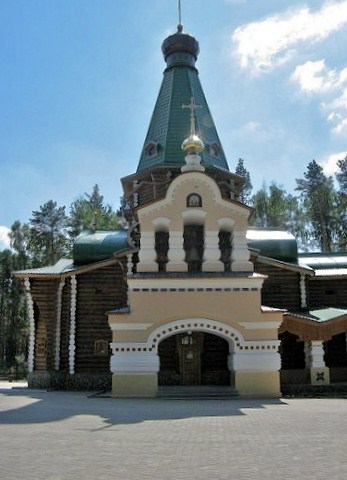
Hot churchy action
There is a strange feeling to this place, but not really a bad one. I wonder how well they could know that this really is the location of the execution. Apparently some skulls and human remains were recovered from the site in 1991 and DNA testing later established a link between them and Prince Phillip, the Duke of Edinburgh in England. Tsar Nicholas’s wife’s sister was Phillip’s maternal grandmother, so this established some evidence that the remains are probably royal. They were reburied in 1998 with the other Tsars in St Petersburg inside the SS Peter and Paul Cathedral. In 2000, the Patriarch of the Russian Orthodox Church canonized the Tsar, which explains the signs around the actual pit naming them the ‘Holy Royal Martyrs’. It seems then that Boris and Yuri never really completed the job of removing all the evidence. was that deliberate? I don’t think anything is with this pair.
“We are finished now Boris!”
“Yuri, what are those skulls there?”
“Boris! They are just rocks, the vodka makes you see funny things.”
“Maybe you’re right, we still have a few more bottles to finish too.”
“Let’s bury the ashes and finish the bottles.”
“Da…da…da…Tochna…then we go back to town for the women.”
“What job will we do next week Boris?”
“Next week we make more stairs for buildings.”

The Burial Pit
The central pit is surrounded by a wooden walkway with pictures of the Tsar and the family taken during their life. There are flowers growing all over the pit as we have arrived the week following the July 16th anniversary of the execution. Apparently there are a number of pictures taken at the site that show spiritual occurences; ghostly shadows, faces that weren’t there. We discover the Patriarch of the Russian Orthodox church had conducted the official ceremony while we were busy having the nightmare transfer from St Petersburg through Moscow. The churches at the site are really architectural artworks in their own right. Inside are beautiful icons, chandeliers and paintings. The smell of the wood is pervasive and you can’t help but love the main logs that form the walls, they exude a kind of natural strength and presence that concrete and steel simply never can. I place my hand on at least a few logs in one wall in each church to establish some contact with it, feeling the bare wood texture underneath my hand and fingertips is somehow reassuring. There is also the kind of peacefulness inside the building that holds you in a natural, comfortable silence whilst inside.
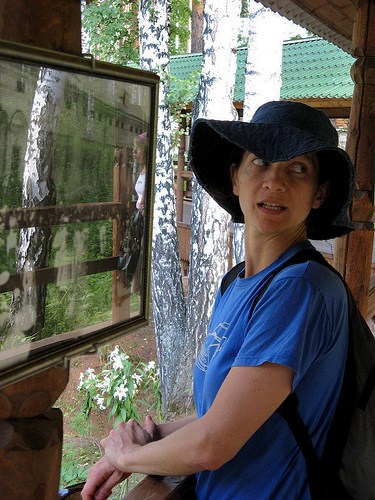
Lari freaking out because that girl in the right of the frame isn't standing behind her
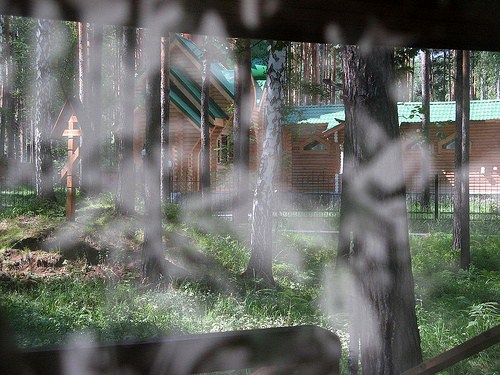
Shadows of the past
We ask our guide what he thinks happened to the Tsar and his family; there are so many amazing stories about their possible survival. Anastasia, the Tsar’s daughter is the best known one, but little evidence supports the idea. It seems more the realm of people spotting Elvis Presley and Jimi Hendrix having a chat at the back of a convenience store late at night. His preferred story is the one of the doppelgangers, that the Bolsheviks never had the real family, just the twin family used to ensure safety on long trips. I was surprised at this, there’s no evidence to support it, in particular you would have expected the former Tsar to be living in exile somewhere – as has happened with so many other regime changes. As soon as the Soviet Union disintegrated, you would have had the descendants trying to claim the throne. There have been a number of claimants to the Russian throne, but none have been proven or established as anything more than a dedicated confidence trick, which makes me discount the theory. The reality is the Romanov family were ruthless, paranoid tyrants who thought nothing of sacrificing vast numbers of their people to starvation, war and work camps. Deportation to Siberian gulags was not a Bolshevik invention; they just continued the Tsar’s idea. I suppose the only question that remains is if anything ever really changed, to which the answer seems to be; not really.

Proper Russian Orthodox cross replete with nuns

How many domes does a church need anyway?
We spend an hour or so slowly moving from building to building through the monastery grounds. We only encounter a few of the actual monks, there aren’t many in residence, but the one who approaches us closest has a very curious demeanour. It’s a kind of vicious intensity of being, a focussed existence burning hard and bright. I don’t know how to react to it; I’ve never felt anything like it before. As he passes by I ask our guide if they’re all like that. He admits that Russian monks are quite intense and he’s never really comfortable around them. As we reach the end of the tour we slide slowly out of the gate and look through the inevitable tourist shops for some appropriate souvenir. I was never asked why I wasn’t wearing a skirt the whole time and noticed a few other Russian local men wearing shorts like mine. I ask our guide why they wanted to build a monastery here. He looks thoughtful for a moment and says,
“This is part of the government’s plan to encourage the Russian people to feel strongly about their country again. The church is much more a part of our lives since the end of the union, but most people don’t really believe.”
I ponder that and consider the curious motivations of the government, if they spent more time actually looking after their own population; the whole country would enter a new age.
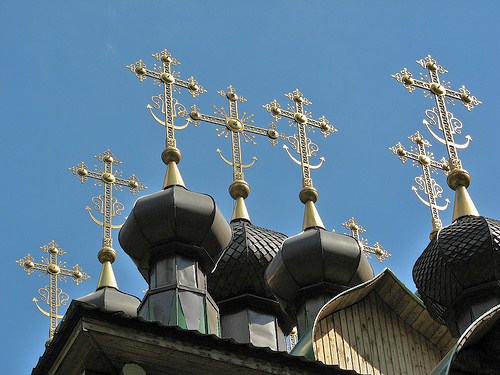
Hot Russian onion dome action
On the trip back into town we discover how easy it is to acquire fireworks in Russia and we ask our guide if he can tell us where a good shop is. He takes Don’s guide and marks the spot on the map and says,
“This is the best one; if you go here you will be very happy.”
We begin to laugh and feel elated at the prospect of setting off a vast amount of incendiary devices in the middle of Russia. He further advises us,
“The markets near the fireworks shop are worth a visit, but be warned that most of the beautiful stones there, like malachite, that are turned into jewellery and sculptures are from Africa and not Russian at all.”
With that he drops us in the city next to the geological museum, which turns out to be across the road from the second Scottish theme pub in the city. Same name, Gordon’s, slightly different theme and sadly lacking the midgets in kilts in the window. We fill some time by wandering through the geological museum, which does indeed have an amazing array of minerals on display, many of which can only be found in the Ural Mountains. I ponder on buying something made from one of these rare minerals until I see the cost, pushing them to the precious end of the semi-precious stone marketplace. There are some beautiful carved pieces here, all kinds of animals, even some Faberge eggs, but I just can’t justify the excessive cost for something so purely decorative; even if it is absolutely and uniquely Russian.

Can you see the bearded man's face?


Leave a Reply